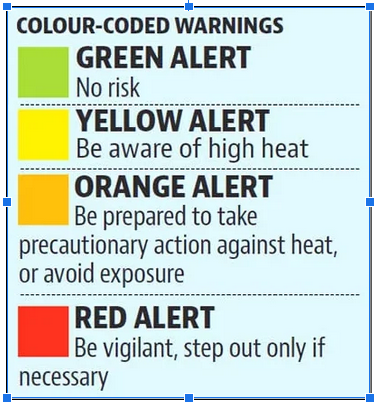News Excerpt:
Heat waves need to be declared as a disaster.
More about the news:
According to a report released by the non-profit research organization iForest, an analysis of heat action plans (HAP) for nine cities and five districts found that there was no clear assessment of heat impact on the local population, lack of legal and financial backing, and that the response mechanism needs to be strengthened by identifying heat waves as a national disaster.
What is a heatwave?
- Heat Waves are a period of unusually high temperatures as compared to what is normally expected over a region which differ from place to place based on the temperature climatology of that region.
- Heatwave is considered if the maximum temperature of a station reaches at least 40C or more for Plains and at least 30C or more for Hilly regions.
How is the heatwave level checked?
- India Meteorological Department provides color-coded Heat Wave warning information through its daily bulletins as well as through a GIS-based visualization platform for the next 5 days.

Why heatwave should be included as a disaster under disaster management:
- iForest analyzed the heatwave of nine cities and five districts:
- The nine cities include Ahmedabad, Bhubaneswar, Chandrapur, Delhi, Jodhpur, Rajkot, Surat, Thane, and Vadodara and the five districts are Ferozepur, Gorakhpur, Hazaribagh, Patiala and Vellore.
- According to the analysis, the heat waves should be notified as a disaster under the Disaster Management Act, of 2005, to ensure focused funding.
- It recommended a review of heat wave definition by the IMD and account for high night temperatures, relative humidity, and ‘real feel’ of temperatures.
- The Ministry of Health and Family Welfare revealed that at least 100 have died from heat-related illnesses from March 1 to June 18 across India though this is likely to be significantly under-reported.
- The high number of deaths has revived discussions on labeling heatwaves as a natural disaster.
- Moreover, since the heat waves will increase across the country with increasing global warming, heat waves will have a devastating impact on health, the economy, and livelihoods, developing a comprehensive HAP will help save lives and livelihoods.
|
National Disaster Management Authority (NDMA):
|


